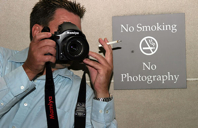 Why don’t textbook publishers use more humor? Humor frequently plays a critical role in revealing truth and puncturing pomposity. Textbooks should be a path to the truth – and they are frequently so pompous they could bore a narcoleptic sloth to death.
Why don’t textbook publishers use more humor? Humor frequently plays a critical role in revealing truth and puncturing pomposity. Textbooks should be a path to the truth – and they are frequently so pompous they could bore a narcoleptic sloth to death.
As an example the “You Suck at Photoshop” series on YouTube is pure snarky genius. Our guide and teacher is the hapless Donnie Hoyle. During serious lessons on Photoshop we learn about Donnie’s unfaithful wife, his lame World of Warcraft buddies, and his egomaniac boss at Phebco (motto: Innovation, Vision, Waste). He uses the mesh tool to paste a copy of his marriage certificate in the windshield of the boyfriend’s car, compound paths to paste his wedding ring into a barren dessert scene, and pucker and bloat to reveal his bosses inner piggishness.
View episode 1 to get a taste of the series (warning – strong language, adult themes, and snark).
Something this edgy would never work in school where a wide range of moral codes should be respected. But I share it anyway because I think it brings out some interesting insights into how humor can support teaching.
1. There is a story line. The humor works partly because it builds over the videos. The tools he shows are all very different, but the reason he is using them (revenge!) provides a thread. We want to learn what is going to happen next to his marriage and job. It provides a real world context for how you can use the tools – although one with tongue firmly in cheek.
2. There are easter eggs that draw us back in. A lot of the humor is never stated, it is in the images that flash by while he narrates (the titles of his friends photos for example). This leads to repeated viewing to get all the jokes. Every time you watch it the underlying Photoshop lesson is etched a little deeper. It provides a motivation to review the material.
3. The humor itself is a mnemonic form. To recall the techie Photoshop tool you just have to recall the joke, which is much more accessible to most human brains.
 4. Snark is the new black. We live in a Mad Magazine culture that is a reaction to the spin and hype that we swim in. It is a defense mechanism against the 4,000 ads a typical urban dweller sees in a day. If we want to connect with youth culture we need to take this aspect of it into account.
4. Snark is the new black. We live in a Mad Magazine culture that is a reaction to the spin and hype that we swim in. It is a defense mechanism against the 4,000 ads a typical urban dweller sees in a day. If we want to connect with youth culture we need to take this aspect of it into account.
If you are interested in learning more I recommend an academic paper titled “Using Humor In the Introductory Statistics Course.” No joke.
Humor is hard and as an art form it is risky. But that doesn’t mean it shouldn’t be used where it can help engage, motivate, and anchor new learning experiences.
But I don’t harbor any illusions – the risk averse world of textbook publishing is not likely to move in this direction any time soon. On the other hand, that risk aversion creates a business opportunity for carving out a niche for someone brave.
Thanks to Donnie I now suck slightly less at Photoshop.
 The Education Business Blog
The Education Business Blog

